Laptop Mag Verdict
The Razer Core can transform your Razer Blade Stealth ultraportable into a gaming laptop via Thunderbolt.
Pros
- +
Slim, attractive design
- +
Easy plug-and-play setup
- +
Customizable lighting
- +
Works with some non-Razer laptops
Cons
- -
Expensive
- -
Limited compatibility
Why you can trust Laptop Mag
When is an ultraportable not an ultraportable? If it's a Razer Blade Stealth, the answer is "when it's attached to an external graphics amplifier." The Razer Core graphics amp combines the sleek looks and vivid lighting of Razer products with the power of your favorite graphics card to turn your lightweight laptop into a serious gaming rig. However, the Core's $499 price tag (before you buy the graphics card) and limited compatibility make it an expensive proposition for anyone who doesn't really want to play high-end games on an Ultrabook.
Laptop Compatibility: What does the Core Work With?
The Razer Core works best with the Razer Blade Stealth, a slim, 12.5-inch ultraportable that starts at $899. If you purchase the Stealth and Core together, you can save $100. But this isn't the only laptop that works with the graphics amp.
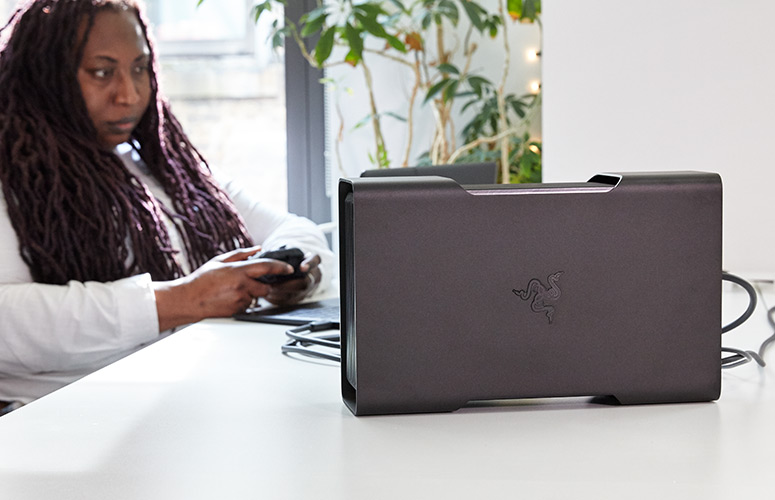
The Razer Core is one of the first graphics amplifiers to feature a Thunderbolt 3 port. Unlike Alienware, with its proprietary graphics-amp port, the Core can theoretically work with a wide variety of laptops, from business laptops to 2-in-1s. However, for that to happen, laptop makers are going to have to get with the program. Although the number of laptops with Thunderbolt 3 ports is increasing, due to manufacturer meddling, the quality of these ports can vary. In order for your non-Razer ultraportable to stand a chance of working with the Core, your machine has to have a four-lane Thunderbolt port instead of a two-lane, something most manufacturers don't advertise.
In our experience, most ultraportables equipped with a Thunderbolt port won't work with the Core. When I tried connecting it to the Dell XPS 13, I received an error message stating the notebook couldn't recognize the external GPU, while the HP Spectre x360 just ignored the device altogether. I did, however, get the Core to work with an Alienware 13 and the Lenovo ThinkPad X1 Carbon. Some other publications report successfully using a MacBook Pro 13 or 15-inch (running Windows 10).
Alienware's graphics amp works only with the company's own laptops. But as of last year, each of the manufacturer's laptops, including the behemoth Alienware 17, supports the amp in case you have a superpowerful GPU laying around to turbocharge your system.
MORE: The Best Gaming Laptops
Design
The Core is undeniably Razer. Like with the company's notebooks, the Core's exterior consists mainly of that ebony color I've come to know and adore. A large metallic grill in the left side lets you gaze at your graphics card bathed in an ethereal green light show (that is, until you customize the lighting). Razer's tri-headed serpent logo is stamped onto the right side.
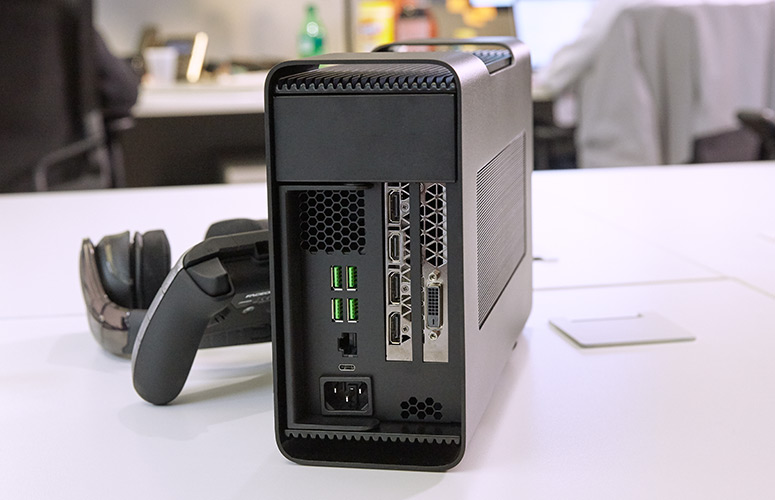
Weighing 10.8 pounds and measuring 11.8 x 5.1 x 1.7-inches, the Core can easily slide into a cubby hole, although it would be a shame to hide something this pretty. The Alienware Graphics Amplifier is lighter, at 7.7 pounds, but wider (7.3 x 16.1 x 6.8 inches), thanks to its trapezoidal shape.
A row of metallic flanges along the top and rear of the device look sophisticated while providing some ventilation to keep your GPU nice and cool. All of the ports you'll need to support a respectable gaming battle station are positioned at the back of the device, including four USB 3.0 ports, a Thunderbolt 3 port, Gigabit Ethernet and a power jack. The amount of HDMI ports and DisplayPorts depends on the graphics card you insert into the Core.
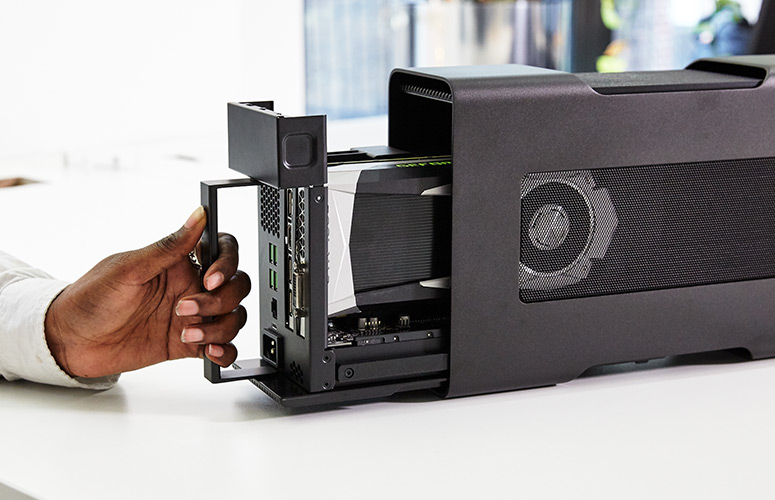
A large, metal Quick Release handle is tucked away on the left, waiting to be deployed so you can add your GPU and start gaming.
Flashing Lights
Just like the laptops, mice and headsets in Razer's stable, the Core features the company's hypnotically beautiful Chroma backlighting, which is positioned along the amp's interior and undercarriage. I used Razer's cloud-based Synapse to transform the Core from a handsome metal brick into a show-stealing conversation starter.
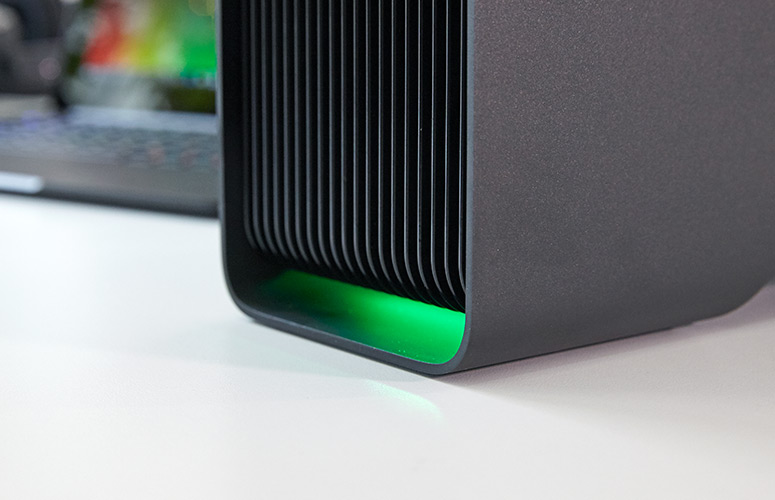
Similar to other Razer products, the Core can tap into 16.7 million colors to brighten up your gaming experience. You can program the Core with its own lightning effects or have it sync up with the Stealth for double the pleasure.
Setup
Placing your GPU into the Core is laughably easy. Just grab the Quick Release handle and pull it to access the interior housing. Next, remove the holding screw at the top and insert your graphics card. Once the GPU has been positioned correctly, replace the screw to hold the card in place. From there, you just slide the housing back into its case and connect the proper plugs. Just remember to restart your Stealth once everything is set up or else the laptop won't recognize the new GPU.
MORE: Which GPU is Right For You
Graphics Performance: You Get Out What You Put In
Similar to the Alienware Graphics Amplifier, the Core is B.Y.O.G.C. (bring your own graphics card). That means that on top of the $499 you shell out for the amp, you have to spend a few hundred more for a graphics card.
Thankfully, it doesn't take much to transform the Stealth from a sexier-than-average ultraportable into a formidable gaming laptop. It can support a number of GPUs from both AMD and Nvidia, including older cards like the AMD Radeon R9 285 ($199) or the Nvidia GeForce GTX 750 ($109), as well as the current Radeon RX 480 ($239) and GeForce GTX 1080 ($499).
For our testing, we ran our typical gaming benchmarks using the AMD R9 460, AMD R9 480, Nvidia GTX 1060 and Nvidia GTX 1080. We started with Hitman on Very High at 1920 x 1080, which yielded scores of 24 frames per second and 55 fps from the R9 460 and GTX 1080. The GTX 1060 and R9 480 were in a dead heat, at 39 fps. During the Grand Theft Auto V test, the R9 580, GTX 1060 and GTX 1080 delivered 30 fps, 46 fps and 61 fps. The RX 460 notched 16 fps, which is below our 30-fps playability threshold.
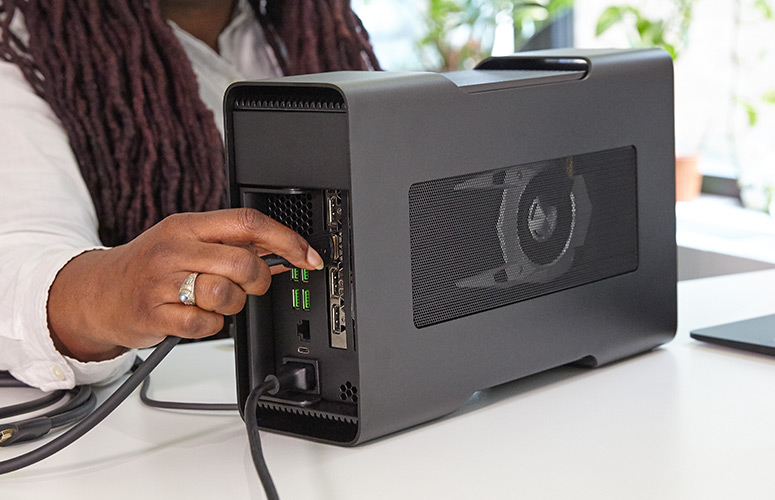
Keep in mind, these are the scores we obtained on the Stealth's display. If you want higher frame rates, get a monitor. When we ran the benchmarks using an external display, the R9 480 notched 42 fps on Rise of the Tomb Raider, while the GTX 1080 GPU jumped to 60 fps. That's a jump of tk and tk percent. The reason for the frame-rate increase is that I wasn't making the Thunderbolt cable do double-duty, pushing image info back to the Stealth while simultaneously sending data to the graphics card.
We ran the SteamVR Performance Test to check for virtual reality support, and the GTX 1080 maxed out the test with a score of 11.
MORE: Laptops with the Longest Battery Life
Bottom Line
The Razer Core is a sleek way to transform lightweight laptops like the Blade Stealth into ultraportable gaming rigs. All you need to make the jump is the Core, a graphics card of your choosing and a compatible laptop. However, $499 is a bit steep for the pleasure. Alienware's graphics amp costs $199 and serves the same function, although it works only with that company's laptops.
The Core would be even more useful if it worked with a wider variety of laptops or, at least, if manufacturers and Razer itself published a compatibility list. However, if you have a Blade Stealth or one of the few other systems that can connect to the Core, you can truly have your cake and eat it, too.
Credit: Laptop Mag/Jeremy Lips
Razer Core Specs
| Accessories Type | Laptop Docks |
| Brand | Razer |
| Company Website | http://www.razer.com |
| Size | 11.8 x 5.1 x 1.7 inches |
| Weight | 7.7 pounds |

Sherri L. Smith has been cranking out product reviews for Laptopmag.com since 2011. In that time, she's reviewed more than her share of laptops, tablets, smartphones and everything in between. The resident gamer and audio junkie, Sherri was previously a managing editor for Black Web 2.0 and contributed to BET.Com and Popgadget.
